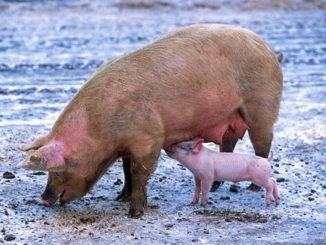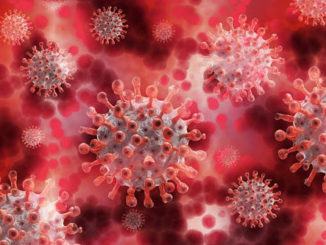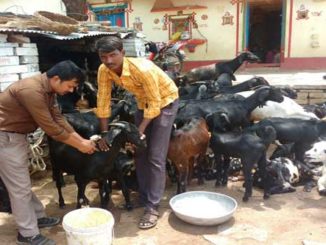Introduction
In some cases, animal diseases can cause major social, economic, and environmental impact, as well as posing a risk to human health. Due to the effects of global change, many livestock-related dangers, as well as many zoonotic infectious illnesses, have global ramifications. Furthermore, the expense of creating and maintaining infectious disease research infrastructure is increasing as technical study methodologies get more complex and safety standards for bio-contained research facilities become more stringent in the meantime, financing for ongoing research expenses is growing scarce. The goal was to improve the coordination of research operations on major infectious diseases of livestock and zoonoses so that better management approaches could be swiftly transferred to the farming industry. Many parts of the world are still plagued by livestock illnesses, which are wreaking havoc on animal health and affecting national and international trade. Changes in the environment (climate, hydrology, ecosystem disruption, etc. ), agriculture and food production (intensive systems of husbandry, monoculture farming, food processing, etc. ), and the demography and connectivity of the modern “global” village (population growth, urbanisation, international trading, world tourism, and rapid transportation, etc.) continue to fuel the emergence of threats from old and new pathogens, which can cause significant damage at local, regional, and global levels. On a cow farm, for example, virus or bacteria-induced abortions could have a big impact on calves’ productivity. Animal diseases, on the other hand, can jeopardise a country’s economy if they have a direct impact on production efficiency as well as a variety of indirect effects on international trade in animals and animal-derived products.
Domestic animal diseases affect not only animal production and trade, but they can also be passed to humans and cause disease (zoonoses). A zoonosis with known lethal consequences, such as the H5N1 subtype of avian influenza, poses a significant pandemic risk. By consuming infected food, humans can get bovine spongiform encephalopathy (BSE), a prion disease that typically affects animals. In the United Kingdom in the 1990s, the cost of the BSE outbreak was estimated to be in the millions of pounds. The human immunodeficiency virus (HIV), which causes acquired immunodeficiency syndrome, was disseminated by cross-species transmission between African apes and humans (AIDS). There are many more infections that have crossed the species barrier from animals to humans, which will be discussed in detail in the zoonoses and emerging illnesses sections.
Major viral disease of livestock
Foot and mouth disease
Artiodactylae are the primary victims of FMD, which is a highly infectious disease (cattle, pigs, sheep, goats, and a variety of wild ungulates). FMD is a common disease for which the World Organization for Animal Health must be notified. Since the sixteenth century, it has been recognised as a serious epidemic illness endangering the cattle business, and it is still a major global animal health problem today. FMD dates back to 1546 A.D. in Verona, Italy, when a monk named Hieronymus Fracastorius noticed a disease outbreak in cattle. Friedrich Loeffler and Paul Frosch discovered that FMD is induced by a filterable substance over 400 years later, in 1897. It was the first time an animal disease had been connected to a filterable agent, and it marked the beginning of the virology period.
The etiological agent, foot-and-mouth disease virus (FMDV), belongs to the Aphthovirus genus of the Picornaviridae family. Although each serotype has generated a bevvy of subtypes, the virus is divided into seven serologically and genetically distinct groups: O, A, C, Asia1, SAT1, SAT2, and SAT3. Valee and Caree named serotypes O and A in France, whereas Waldmann and Trautwein named serotype C in 1926. In samples taken during the South African FMD outbreak, FMDV serotypes SAT1, SAT2, and SAT3 were discovered. Pakistan is the home of Asia1, the sixth serotype.
FMDV is disseminated mechanically through infected animal products, non-susceptible animals, agricultural implements, people, cars, and airborne transmission. Virus virulence (the severity of lesions, the volume, and length of virus release), particle stability in diverse microenvironments, and the capacity for long-term persistence, to name a few factors, all influence FMD epidemiology.
Bluetongue
FMD is a highly transmissible illness since only a few infective particles can infect a host. Infected animal products, non-susceptible animals, agricultural implements, people, autos, and airborne transmission are all ways FMDV is spread mechanically. Despite the fact that BTV can infect any ruminant, sheep are by far the most afflicted domestic animal in the United States, followed by goats and white-tail deer. Although asymptomatic infection in cattle is prevalent, epidemiologically, it is crucial for BTV survival in an endemic area. Depending on the breed, sheep are more or less vulnerable to bluetongue. Tropical African and Asian breeds, on the whole, show no major clinical indications when infected. BTV is distributed by the biting midge Culicoides spp., which is an insect vector. One of the most common BTV vectors is Culicoides imicola. C. imicola was originally only found in Africa and Southeast Asia, but because to climate change, it has expanded over southern Europe and even into Switzerland. Culicoides obsoletus (and closely related species) and Culicoides pulicaris, the latter likely the most common midge in central and northern Europe, can both act as BTV vectors. As a result, BTV transmission is limited to places and seasons where vector activity is allowed.
Bluetongue is a tropical and subtropical disease that has recently expanded to southern, central, and even northern Europe. The spread of BTV corresponds to the expansion of Culicoides spp. over the world. Because cattle do not succumb to illness and their viremia lasts twice as long as sheep, they serve an important epidemiological role in disease transmission. Midges also prefer to bite large animals like cattle and horses rather than sheep.
Influenza
Humans, birds, pigs, horses, dogs, cats, and marine mammals such as whales and seals are all susceptible to influenza viruses. They cause enormous losses in poultry, pigs, turkeys, and the horse racing industry, as illustrated by the current threat posed by the H5N1 subtype of avian influenza, as well as being a serious human health concern. Viruses have been isolated from over 105 different wild bird species, indicating that migratory birds are the main reservoir for influenza viruses.
Influenza viruses belong to the Orthomyxoviridae family. In the influenza article, the main characteristics of this virus family will be covered in depth. Orthomyxoviruses have a single-stranded, negative-sense, segmented RNA genome. Gene fragments can be reassigned among members of the same genus because of the segmented genome, which can be lethal. The pandemics of 1957 and 1968 were generated by recombinant viruses with avian gene sequences brought into a human environment.
The three viral proteins that coat the envelope are neuraminidase (NA), hemagglutinin (HA), and the M2 protein. HA and NA antigenic features distinguish different influenza A subtypes. Currently, there are 16 HA subtypes and 9 NA subtypes. Antigenic drift is the selection of mutants that can no longer be neutralised by antibodies to the ancestral strain as a result of immunological pressure applied by neutralising antibodies. Antigenic shift, or the introduction of novel HA or NA variants (usually through reassortment), could result in more pronounced antigenic changes. If these newly introduced variants are immunologically distinct from previously circulating strains, they could result in higher infection rates or perhaps pandemics.
Classical swine fever
Classic swine fever is spread by pigs and wild boars (also known as hog cholera). CSF is caused by the classical swine fever virus (CSFV), which belongs to the Flaviviridae family of the Pestivirus genus. It is without a doubt the most lethal transmissible disease in pigs. Virions have a positive, single-stranded RNA genome with a diameter of 40–60 nm and a length of 12.5 kb.
The severity of the sickness caused by CSFV varies depending on the breed and age of the animals afflicted the virus’s virulence, and other undefined factors. After a 2–4-day incubation period, anorexia, fever, and depression are prominent symptoms of the typical kind of CSF, This is followed by opportunistic infection-induced pneumonia, vomiting, and diarrhoea or constipation. Some neurological signs and symptoms include paralysis, spinning, tremors, and convulsions.
Only a few animals are affected in the early stages of an outbreak, but morbidity can approach 100% of the herd after around 10 days. Mortality rates in a susceptible herd might also reach 100%. Chronic CSF has been documented as well, with a prolonged incubation period, occasional clinical signs, and death happening weeks or months after infection. Infection of the uterus in sows is common, and it can lead to abortion, foetal mummification, or stillbirth. Piglets can be infected for a long period and die weeks or months after birth if they are not treated.
Ingestion is the most common route for viral entry, with viral replication taking place in the epithelial crypts of the tonsils, as well as granulocytic cells and monocytes. A second cycle of viral replication in lymphoid organs, endothelium cells, and bone marrow causes leukopenia, severe immunosuppression, and haemorrhages due to endothelial damage. Petechial haemorrhages, both submucosal and subserosal, as well as congestion, are common gross lesions.
Sheep pox and Goat pox
The most frequent pox illnesses in domestic ruminants are sheep and goat pox. The viruses that cause them are the sheep pox virus (SPV) and the goat pox virus (GTPV). Both disorders affect southern Asia, India, and northern and central Africa. SPV and GTPV are members of the Poxviridae family (subfamily Chordopoxviridae, genus Capripoxvirus). SPV and GTPV particles are enclosed and oval in form, with diameters ranging from 200 to 270 nm. The genomes of SPV and GTPV are roughly 150 kb in size and 96 percent identical. Lumpy skin disease virus, the other member of the Capripoxvirus genus, is highly similar to both SPV and GTPV.
Newcastle Disease
Newcastle disease is one of the deadliest viral illnesses that may afflict birds. Newcastle disease is caused by a group of single-stranded, nonsegmented, negative-sense RNA viruses that are single-stranded, nonsegmented, and nonsegmented stranded, nonsegmented stranded, nonsegmented stranded, nonsegmented stranded, nonsegmented stranded, nonsegmented stranded, nonsegmented (NDV). With a genomic size of 15.2 kb, NDV is a paramyxoviridae virus from the genus Avulavirus. Based on its virulence, NDV was previously split into three strains: lentogenic, mesogenic, and velogenic. Low virulence NDV (LVNDV) refers to lentogenic strains, while virulent NDV (vNDV) relates to mesogenic and velogenic strains (loNDV).
Newcastle disease can appear in a variety of ways, ranging from mild to fatal, depending on the host and virus features. Velogens, which can cause widespread bleeding lesions in the gastrointestinal tract (viscerotropic strains) as well as neurologic symptoms, are the most dangerous NDVs (neurotropic strains). On the other hand, lentogenic virus infection results in asymptomatic illnesses or, at best, a moderate respiratory presentation. The phenotype of mesogenic NDV is intermediate, with modest respiratory symptoms and, in rare cases, neurological indications. Symptoms of the disease include dyspnea, clonic muscular gasping, and cyanosis of the comb and wattles, which usually appear after a 5-day incubation period. Other symptoms include weakness, loss of appetite, and somnolence. When the neurological system is involved, symptoms like as paralysis of the wings or legs (or both) are prevalent, as are ataxia, torticollis, clonic spasms, and abnormal head motions. Viscerotropic NDV infection causes foamy mucus in the throat, crop dilatation, and diarrhoea.
Egg production is quickly harmed, and eggs from infected animals show a drop in albumen quality as well as shell loss or depigmentation. Because of the vague clinical indications and epidemiological significance of NDV, virus isolation (typically from the brain, spleen, or lungs) and serological testing are required for diagnosis.
Infectious bovine rhinotracheitis
Foamy mucus in the throat, crop dilatation, and diarrhoea are all symptoms of viscerotropic NDV infection. It’s highly contagious, causing respiratory disease to spread quickly among cattle in close quarters, especially in feedlots and when herds of cattle are transported. IBR is a type of acute infection marked by obvious symptoms such as fever, salivation, rhinitis (red nose), conjunctivitis (red, watery eyes), inappetance, and dyspenea (difficult breathing). There is a lot of nasal discharge and the nasal mucosa and muzzle are inflamed. Large, consolidated hemorrhagic (red) patches or white plaques arise from nasal lesions. Respiratory discomfort worsens in extreme cases, and open-mouth breathing is visible. Secondary bacterial infection can develop if the main BHV-1 infection does not clear within five to ten days, leading to bronchopneumonia and, in severe cases, death. Infertility issues, abortion, and birth abnormalities are all signs that the reproductive system is implicated. One of the first symptoms of BHV-1 infection in mature cattle is a decrease in milk output.
Infectious bronchitis
Infection is a highly contagious, acute, and costly disease that affects individuals all over the world. The Avian Coronavirus causes IB. Several IB serotypes have been detected in the field, including the basic Massachusetts type and several variations such as IB 4/91, QX, Arkansas, and Connecticut. By airborne transmission, the virus spreads fast from bird to bird. The virus can also be spread from farm to farm through the air between chicken houses. The period of incubation is only 1-3 days. The IB-virus is most commonly seen in chickens, although it can also be found in quail and pheasants. Other species may act as vectors, as evidenced by the detection of IB virus in other species without clinical indications.
The respiratory type of the disease causes gasping, sneezing, tracheal rales, and nasal discharge in young hens. Chicks are generally sad and have reduced feed consumption. In general, mortality is rare unless the infection is worsened by subsequent bacterial infections (like E.coli). After initial respiratory indications, birds with a nephropathogenic type of IB virus become more depressed produce wet droppings, which result in moist litter, increased water intake, and higher mortality. Adult “laying” birds (layers and breeders) display a decline in egg production and a loss of egg quality (shell deformation and internal egg alterations) following initial respiratory symptoms, resulting in more second class eggs, reducing the hatchability rate of fertile eggs and day-old chick quality. The QX variety of IB is associated with a condition known as “false layers,” in which flocks do not reach their maximal egg production and many birds adopt a “penguin-like posture.” In a flock, clinical indications and postmortem lesions were followed by laboratory confirmation based on virus isolation and PCR identification. Serology employing HI, Elisa, or VN assays on matched blood samples. IB does not have a treatment. Secondary bacterial infections are treated with antibiotics. Vaccination using strain-specific or cross-protective live vaccines, as well as the addition of inactivated vaccines at the point of lay for layers and breeders, to promote long-term systemic immunity.
Infectious Laryngotracheitis
The Herpesvirus that causes ILT is caused by a single serotype. ILT enters the body through the upper respiratory tract and the eyes. Field transmission occurs through direct contact between birds and/or transfer through contaminated persons or equipment (visitors, shoes, clothing, egg boxes, and transport crates). The incubation time varies between 4 and 12 days. Affected species the major natural host is chickens; however other species (such as pheasants) can also be affected. Nasal discharge and moist rales are clinical markers in laying birds, followed by gasping, severe respiratory distress, and expectoration of blood-stained mucus. The production of eggs may drop by 10% to 50%, but it will return to normal in 3 to 4 weeks. The mortality rate might range from 5% to 70%. In comparison to IB and ND, spread through a chicken house is slower. Lesions discovered after death the larynx and trachea are the areas of the respiratory tract where lesions are most noticeable. Tracheitis with haemorrhagic and/or diphteric alterations can occur depending on the severity of the illness. ILT is suggested by a clinical picture of birds with respiratory distress and expectoration of bloody mucus. Laboratory confirmation includes histopathology showing intra nuclear inclusion bodies in tracheal epithelial cells, virus isolation from tracheal swabs on embrocated chicken eggs, and virus identification using PCR or IFT on tracheal samples. ILT has no cure; however, early immunisation of an affected flock may help to prevent the spread of the disease and minimise the outbreak. Control and prevention Vaccination is the preferred technique of control in many nations. Vaccination is not allowed or is only allowed under certain conditions in several countries. Live traditional CEO ILT vaccinations are effective at reducing clinical problems, but they run the danger of spreading and virulence after several passages through hens. Recent outbreaks have frequently shown a link to the live vaccination strains administered in a particular area. As a result, the new generation of recombinant vector vaccines is better for controlling and preventing ILT. Because there is no whole ILT virus involved, recombinant vaccines based on HVT-vector bearing insertion of essential immunogenic ILT proteins demonstrate good efficacy and do not propagate or revert to virulence.
Conclusion
The biology of viral agents has been greatly aided by studies on animal pathogens over the years. Farm animal pathogen research sparked the development of new disciplines and led to the discovery of new human infections. Despite scientific and technological advancements over the previous two centuries, viral and bacterial infections of domestic animal species continue to have a significant influence on animal health and agriculture, as well as both developed and emerging countries’ economies. Changes in the environment and climate can have an impact on how animals interact with one another and with humans. As a result of these changes, new infections may arise or old pathogens may resurface. As a result, it is vital that resources be allocated to veterinary pathogen research and surveillance in order to protect and improve the livestock and poultry industries.






Be the first to comment